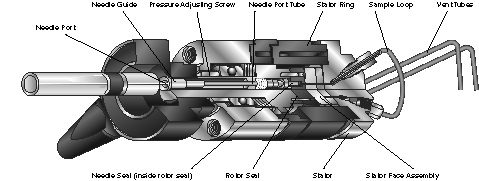 |
|||||||||

Comments
The most common cause of early rotor seal failure is surface scratches caused by abrasive particles. These particles can be debris from the sample, mobile phase, or salt crystals from buffer solutions. In the case of metal injectors, particles or burrs from the tubing or fittings can also cause scratching.
In some orientations of the injector, a leak between the stator and stator ring will appear as though the leak is at a fitting in the stator. Likewise, a leak at a fitting may appear as though the leak is between the stator and stator ring. Confirm the true source of the leak before making adjustments.
The following
practices provide maximum rotor seal lifetime:
1) Check all tubing for burrs and flush it before connecting to the system.
2) Filter particles from the mobile phase and filter samples if they are
not clean.
3) Install a filter between the pump and injector to protect the injector
from particles from the pump or mobile phase.
4) Frequently flush the injector with water when using buffers, especially
before shutting down.
Leaks
Leaks can appear at three locations in the injector: (1) needle port, (2) vent tubes, or (3) the gap between the stator and stator ring.A leak can be caused by a damaged rotor seal, but there are many leak problems that do not require seal replacement. In the latter case a simple adjustment of the injector, without disassembly, can fix the leak. Read Symptoms #1, #2, and #3 before taking action.

© 2000 Rheodyne All rights reserved